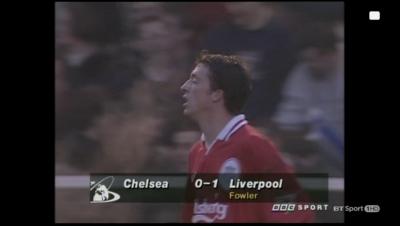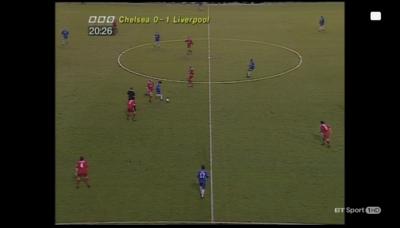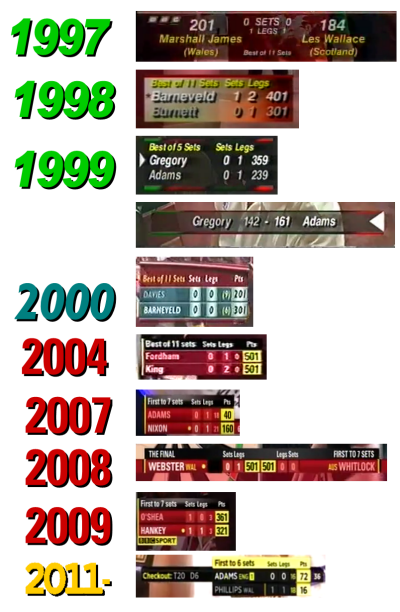S7
Scorebars in the U.S.
There's quite a good article about American TV graphics in the New York Times . It covers some stuff already mentioned in this thead – like the 1994 World Cup, when the home broadcasters put scoreboards on the screen, maybe for the first time in the U.S.:
https://www.nytimes.com/2014/06/13/sports/the-tv-score-box-that-grew-and-grew.html



I suspect that this may not be the earliest use of scorebars on American television. With so many stations, big and small, it wouldn't be surprising if someone else had experimented with something similar. (As C4 did in the UK.)
The "Fox Box" wasn't groundbreaking. It wasn't even the first scorebar on American television. It was introduced in 1994, two months after ESPN's soccer scorebar, two years after Sky's, and eleven years after Channel 4's basketball scoreboard.
So, why even mention it? Well, it might be the most expensive scorebar in history: it cost $395 million a year for Fox to put that graphic on the screen. (Admittedly, they also got a few American football games included in that price.) Just like Sky buying the Premier League rights, Fox's deal with the NFL changed the sport off the field, and on-screen. The situations are very similar – in fact, some of the same people were involved at Sky and Fox. With the score graphics, David Hill was responsible in both cases.
NFL American football coverage already contained quite a lot of graphics. In the 1970s and '80s, it was common to display every down (e.g. "1st and 10") at the foot of the screen, and other information between each play. Fox continued this, but added a scoreboard with a clock, in the top-left of the screen.
In week 1 of the 1994 season, Fox showed six games in different regions. From the one game that's available to view, it looks like they tried to bring in the "Fox Box" stealthily, without scaring the horses... not easy when you're having technical issues.
The scorebar didn't appear in the first 15 minutes of the game broadcast. That may have been intentional, as it was still 0-0. Soon after the first touchdown, the scorebar appeared, but only as white text and outlines, too thin to read easily. Secondly, a solid black background was added to the score, but the clock disappeared. Then finally, the background changed to grey shading, with the graphics eventually all returning.
Philadelphia Eagles at New York Giants, NFL, 04.09.1994




The scoreboard remained, with the grey background, in week 2 and 3 of the season, and became a fixture of Fox's NFL coverage.


The name "Fox Box" was already established, appearing in a Washington Post article in 1994 when Fox started showing the NFL. According to the NY Times article above, scorebars were later adopted by ESPN in the same sport, and Fox on baseball in 1995.
Their scoreboards nowadays are bigger and full of information, some of it useful. And during a live match there's even a second scorebar in case you need updates from other games, including games in different sports. Sadly they've not yet added a news ticker, stock market data, and your Twitter feed, but give them time. This article covers Fox's different NFL designs from 2014 back to 1994:
http://awfulannouncing.com/2014/the-evolution-of-the-nfl-on-fox-score-bug.html
-
There's quite a good article about American TV graphics in the New York Times . It covers some stuff already mentioned in this thead – like the 1994 World Cup, when the home broadcasters put scoreboards on the screen, maybe for the first time in the U.S.:
https://www.nytimes.com/2014/06/13/sports/the-tv-score-box-that-grew-and-grew.html
Quote:
ABC and ESPN’s primary goal was not to gratify fans. Instead, they were out to solve a dilemma: satisfying five sponsors that wanted their advertising messages to be heard during the games
(NY Times)
(NY Times)



I suspect that this may not be the earliest use of scorebars on American television. With so many stations, big and small, it wouldn't be surprising if someone else had experimented with something similar. (As C4 did in the UK.)
The "Fox Box" wasn't groundbreaking. It wasn't even the first scorebar on American television. It was introduced in 1994, two months after ESPN's soccer scorebar, two years after Sky's, and eleven years after Channel 4's basketball scoreboard.
So, why even mention it? Well, it might be the most expensive scorebar in history: it cost $395 million a year for Fox to put that graphic on the screen. (Admittedly, they also got a few American football games included in that price.) Just like Sky buying the Premier League rights, Fox's deal with the NFL changed the sport off the field, and on-screen. The situations are very similar – in fact, some of the same people were involved at Sky and Fox. With the score graphics, David Hill was responsible in both cases.
NFL American football coverage already contained quite a lot of graphics. In the 1970s and '80s, it was common to display every down (e.g. "1st and 10") at the foot of the screen, and other information between each play. Fox continued this, but added a scoreboard with a clock, in the top-left of the screen.
In week 1 of the 1994 season, Fox showed six games in different regions. From the one game that's available to view, it looks like they tried to bring in the "Fox Box" stealthily, without scaring the horses... not easy when you're having technical issues.
The scorebar didn't appear in the first 15 minutes of the game broadcast. That may have been intentional, as it was still 0-0. Soon after the first touchdown, the scorebar appeared, but only as white text and outlines, too thin to read easily. Secondly, a solid black background was added to the score, but the clock disappeared. Then finally, the background changed to grey shading, with the graphics eventually all returning.
Philadelphia Eagles at New York Giants, NFL, 04.09.1994




The scoreboard remained, with the grey background, in week 2 and 3 of the season, and became a fixture of Fox's NFL coverage.


The name "Fox Box" was already established, appearing in a Washington Post article in 1994 when Fox started showing the NFL. According to the NY Times article above, scorebars were later adopted by ESPN in the same sport, and Fox on baseball in 1995.
Their scoreboards nowadays are bigger and full of information, some of it useful. And during a live match there's even a second scorebar in case you need updates from other games, including games in different sports. Sadly they've not yet added a news ticker, stock market data, and your Twitter feed, but give them time. This article covers Fox's different NFL designs from 2014 back to 1994:
http://awfulannouncing.com/2014/the-evolution-of-the-nfl-on-fox-score-bug.html
-
Last edited by sbahnhof 7 on 3 September 2017 1:40am - 2 times in total


